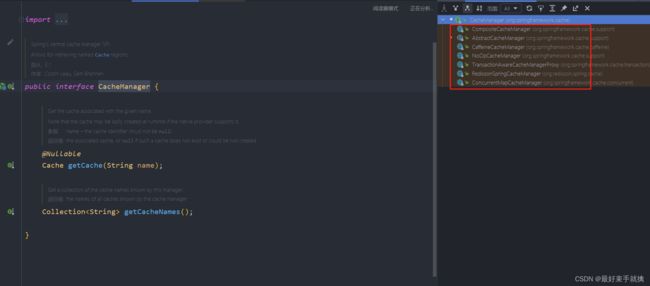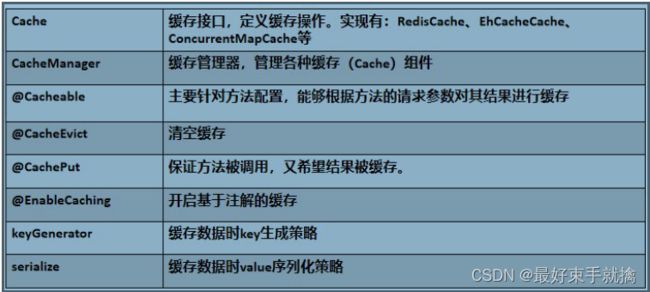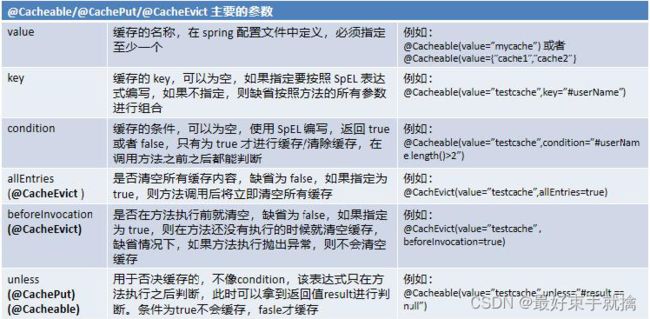SpringCache
Spring 从3.1 开始定义了org.springframework.cache.Cache
和org.springframework.cache.CacheManager 接口来统一不同的缓存技术;
并支持使用JCache(JSR-107)注解简化我们开发;
Cache 接口为缓存的组件规范定义,包含缓存的各种操作集合; Cache 接口下Spring 提供了各种xxxCache 的实现;
如RedisCache , EhCacheCache , ConcurrentMapCache 等;
每次调用需要缓存功能的方法时,Spring 会检查检查指定参数的指定的目标方法是否已
经被调用过;如果有就直接从缓存中获取方法调用后的结果,如果没有就调用方法并缓
存结果后返回给用户。下次调用直接从缓存中获取。
CacheManager 缓存管理器
public interface CacheManager {
//根据缓存名字获取缓存
@Nullable
Cache getCache(String name);
//获取管理的所有缓存的名字
Collection<String> getCacheNames();
}
整合SpringCache
<!-- 引入spring-boot-starter-cache -->
<dependency>
<groupId>org.springframework.boot</groupId>
<artifactId>spring-boot-starter-cache</artifactId>
</dependency>
这里我们使用redis作为缓存
<!-- 引入redis -->
<dependency>
<groupId>org.springframework.boot</groupId>
<artifactId>spring-boot-starter-data-redis</artifactId>
<exclusions>
<exclusion>
<groupId>io.lettuce</groupId>
<artifactId>lettuce-core</artifactId>
</exclusion>
</exclusions>
</dependency>
<!-- jedis不写版本springboot控制 -->
<dependency>
<groupId>redis.clients</groupId>
<artifactId>jedis</artifactId>
</dependency>
配置spring-boot-starter-cache
1.缓存的自动配置
CacheProperties封装了配置文件中可以配置的属性
@ConfigurationProperties(prefix = "spring.cache")
org.springframework.boot.autoconfigure.cache.CacheProperties
CacheConfiguration会根据缓存类型导入RedisCacheConfiguration
RedisCacheConfiguration自动配好了缓存管理器
@Bean
public RedisCacheManager cacheManager(RedisConnectionFactory redisConnectionFactory,
ResourceLoader resourceLoader) {
RedisCacheManagerBuilder builder = RedisCacheManager.builder(redisConnectionFactory)
.cacheDefaults(determineConfiguration(resourceLoader.getClassLoader()));
List<String> cacheNames = this.cacheProperties.getCacheNames();
if (!cacheNames.isEmpty()) {
builder.initialCacheNames(new LinkedHashSet<>(cacheNames));
}
return this.customizerInvoker.customize(builder.build());
}
手动配置
配置使用Redis作为缓存
spring:
cache:
#cache-names: 可以自动配置
type: redis
测试使用缓存
1.开启缓存功能 @Cacheable({"…"})
在启动类添加@EnableCaching 注解,不需要重复配Redis
@EnableCaching 注解
2.使用注解 就能完成缓存操作
//每一个需要缓存的数据都需要指定要放到哪个名字的缓存,缓存的分区,按照业务类型分
@Cacheable({"categroy"}) //代表方法的结果需要缓存 ,如果缓存中有 方法都不用调用,如果缓存中没有,调用方法,将结果放入缓存
@Override
public List<CategoryEntity> getLevel1Categorys() {
long l = System.currentTimeMillis();
List<CategoryEntity> categoryEntityList = baseMapper.selectList(new QueryWrapper<CategoryEntity>().eq("parent_cid", 0));
System.out.println("消耗时间:" + (System.currentTimeMillis() - l));
return categoryEntityList;
}
使用@Cacheable 默认行为
如果缓存中有缓存 方法都不用调用
key值 自动生成
缓存的Value值默认使用JDK序列化机制,将序列化后的数据存到Redis
默认过期时间TTL -1 永不过去
应该要指定缓存存活时间 在配置文件中修改
cache:
#cache-names: 可以自动配置
type: redis
redis:
time-to-live: 3600000 #设置存活时间毫秒
key-prefix: CACHE_ #key前缀 如果制定了前缀就用指定的前缀,如果没有就默认使用缓存的名字作为前缀
use-key-prefix: true # 是否使用前缀
cache-null-values: true # 是否缓存控制 解决缓存穿透
应该要指定缓存的Key 使用key属性 接收SpEL表达式
@Cacheable(value = {"categroy"},key = "#root.method.name")
@Cacheable(value = {"categroy"},key = "'name'")
将数据保存为JSON格式
CacheConfiguration —> RedisCacheConfiguration —> 自动配置了RedisCacheManager —> 初始化所有的缓存 —> 每个缓存决定使用什么配置,配置有就用配置的,配置没有就用默认的(key的前缀等)—>想要修改配置只需要在容器中放一个RedisCacheConfiguration 即可 —> 这个容器就会应用到当前RedisCacheManager 管理的所有缓存分区中
package cn.cloud.xmall.product.config;
import org.springframework.cache.annotation.EnableCaching;
import org.springframework.context.annotation.Bean;
import org.springframework.context.annotation.Configuration;
import org.springframework.data.redis.cache.RedisCacheConfiguration;
import org.springframework.data.redis.serializer.GenericJackson2JsonRedisSerializer;
import org.springframework.data.redis.serializer.RedisSerializationContext;
import org.springframework.data.redis.serializer.StringRedisSerializer;
/**
* @Description: ···
* @author: Freedom
* @QQ: 1556507698
* @date:2022/3/17 13:26
*/
@EnableCaching
@Configuration
public class MyCacheConfig {
@Bean
RedisCacheConfiguration redisCacheConfiguration(){
RedisCacheConfiguration config = RedisCacheConfiguration.defaultCacheConfig();
//config = config.entryTtl();
//key的序列化
config = config.serializeKeysWith(RedisSerializationContext.SerializationPair.fromSerializer(new StringRedisSerializer()));
//值的序列化
config = config.serializeValuesWith(RedisSerializationContext.SerializationPair.fromSerializer(new GenericJackson2JsonRedisSerializer()));
return config;
};
}
问题:
配置文件中的东西没有用上
原因 :
使用我们自己的配置不会从配置文件中取出来配置
package cn.cloud.xmall.product.config;
import org.springframework.boot.autoconfigure.cache.CacheProperties;
import org.springframework.boot.context.properties.EnableConfigurationProperties;
import org.springframework.cache.annotation.EnableCaching;
import org.springframework.context.annotation.Bean;
import org.springframework.context.annotation.Configuration;
import org.springframework.data.redis.cache.RedisCacheConfiguration;
import org.springframework.data.redis.serializer.GenericJackson2JsonRedisSerializer;
import org.springframework.data.redis.serializer.RedisSerializationContext;
import org.springframework.data.redis.serializer.StringRedisSerializer;
/**
* @Description: ···
* @author: Freedom
* @QQ: 1556507698
* @date:2022/3/17 13:26
*/
@EnableConfigurationProperties(CacheProperties.class)
@Configuration
@EnableCaching
public class MyCacheConfig {
// @Autowired
// public CacheProperties cacheProperties;
/**
* 配置文件的配置没有用上
* @return
*/
@Bean
public RedisCacheConfiguration redisCacheConfiguration(CacheProperties cacheProperties) {
RedisCacheConfiguration config = RedisCacheConfiguration.defaultCacheConfig();
// config = config.entryTtl();
//设置Key的序列化方式
config = config.serializeKeysWith(RedisSerializationContext.SerializationPair.fromSerializer(new StringRedisSerializer()));
//设置值的序列化方式
config = config.serializeValuesWith(RedisSerializationContext.SerializationPair.fromSerializer(new GenericJackson2JsonRedisSerializer()));
CacheProperties.Redis redisProperties = cacheProperties.getRedis();
//将配置文件中所有的配置都生效
if (redisProperties.getTimeToLive() != null) {
config = config.entryTtl(redisProperties.getTimeToLive());
}
if (redisProperties.getKeyPrefix() != null) {
config = config.prefixKeysWith(redisProperties.getKeyPrefix());
}
if (!redisProperties.isCacheNullValues()) {
config = config.disableCachingNullValues();
}
if (!redisProperties.isUseKeyPrefix()) {
config = config.disableKeyPrefix();
}
return config;
}
}
从缓存中删除数据 @CacheEvict 失效模式
@CacheEvict(value = "category",key = "'getLevel1Categorys'")
分区value和key必须相同才可以删除
问题:
如果一个修改需要删除两个缓存?如何删除?
@CaChing 组合操作,同时进行多个缓存操作
@Caching(evict = {
@CacheEvict(value = "category",key = "'getLevel1Categorys'"),
@CacheEvict(value = "category",key = "'getCatalogJson'")
})
@Transactional
@Override
public void updateCascade(CategoryEntity category) {
this.updateById(category);
//更新关联表
categoryBrandRelationService.updateCategory(category.getCatId(), category.getName());
}
成功删除
第二种方式:
删除指定分区下所有的缓存,存储统一个类型的数据可以指定为同一个分区,分区名默认就是缓存前缀
@CacheEvict(value = {"category"},allEntries = true)
推荐使用@CaChing
@CaChePut 双写模式使用此注解(解决分布式缓存一致性问题)
Spring-Cache不足
- 读模式
缓存穿透:查询一个null数据
解决:缓存null数据,并设置短暂过期时间,
cache-null-values: true # 是否缓存控制 解决缓存穿透, springcache解决方案
缓存击穿:大量并发进来同时查询一个正好过期的数据
解决:加锁 ???
默认情况下是没有加锁的
1.手写添加缓存方法使用Redisson作为分布式锁
2.@Cacheable(value = {“categroy”},key = “#root.method.name”,sync = true),sync只有Cacheable有这个属性
会进入加锁的方法
缓存雪崩: 大量的key同时过期
解决:添加随机时间,指定过期时间 ,time-to-live: 3600000 #设置存活时间毫秒
- 写模式 (缓存与数据库一致)
读写加锁
引入Canal,感知数据库更新去更新缓存数据
读多写多直接去数据库查询



